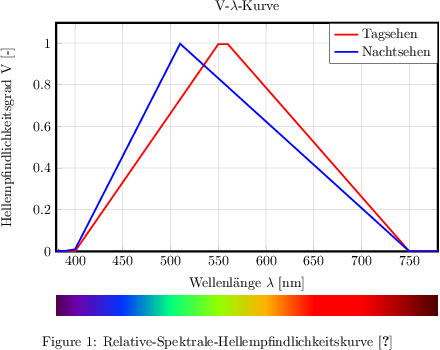Meine V-lambda-Kurve erstreckt sich von etwas unter 350nm bis etwas über 800nm. Ich finde, dass das ganz schick und übersichtlich aussieht. Ich gebe hier mal ein paar Werte für das
380 0.000589 390 0.002209 400 0.00929 510 0.997 750 0.00000076 760 0.000000425 770 0.000000241 780 0.000000139
380 0 390 0.0001 400 0.0004 550 0.995 560 0.995 750 0.00012 760 0.00006 770 0.00003 780 0.000015 Das sichtbare Licht erstreckt sich in einem Bereich von 380nm bis 780nm. Die anderen Bereiche sieht man dann nicht. Kann man dann den Wellenbereich genau der kompletten x-Achse anpassen? Jetzt stimmen nämlich die Zahlen nicht überein! |
|
Das muss man leider alles von Hand machen. Ich bin auf das Shading aus der Frage Lichtspektrum in TikZ zeichnen umgestiegen. Das sieht meiner Meinung nach besser aus. \begin{filecontents*}{Nachtsehen.csv} 380 0.000589 390 0.002209 400 0.00929 510 0.997 750 0.00000076 760 0.000000425 770 0.000000241 780 0.000000139 \end{filecontents*} \begin{filecontents*}{Tagsehen.csv} 380 0 390 0.0001 400 0.0004 550 0.995 560 0.995 750 0.00012 760 0.00006 770 0.00003 780 0.000015 \end{filecontents*} \documentclass{article} \usepackage[utf8]{inputenc} \usepackage{tikz,pgfplots,xcolor} \pgfplotsinvokeforeach{380,400,450,500,550,600,650,700,750,780}{ \definecolor{wl#1}{wave}{#1} } \pgfdeclarehorizontalshading{spectrum}{0.5cm}{ color(0cm)=(wl380); color(0.2cm)=(wl400); color(0.7cm)=(wl450); color(1.2cm)=(wl500); color(1.7cm)=(wl550); color(2.2cm)=(wl600); color(2.7cm)=(wl650); color(3.2cm)=(wl700); color(3.7cm)=(wl750); color(4cm)=(wl780) } \begin{document} \begin{figure}[h] \centering \begin{tikzpicture} \begin{axis}[ymin=0,grid, scale only axis, width=0.8\textwidth, height=0.3\textheight, xmin = 380, xmax = 780, title = {V-$\lambda$-Kurve}, axis line style={ultra thick}, xlabel={Wellenlänge $\lambda$ [nm]}, ylabel={Hellempfindlichkeitsgrad V [-]}, legend style={at={(1,1)}, anchor=north east, nodes=right}, name = main, ] \draw [->] (0,0) -- (5,0) node [midway, below] {Text}; \addplot [no marks, very thick, red]table {Tagsehen.csv}; \addplot [no marks, very thick, blue]table {Nachtsehen.csv}; \legend{Tagsehen, Nachtsehen}; \end{axis} \begin{scope}[shift=(main.below south west)] \pgfmathsetmacro\scale{.8\textwidth/4cm} \node[inner sep=0pt,below,xscale=\scale] at (.4\textwidth,0) {\pgfuseshading{spectrum}}; \end{scope} \end{tikzpicture} \caption {Relative-Spektrale-Hellempfindlichkeitskurve \cite{Reif.2014}} \label{Vlambda} \end{figure} \end{document}
Habs mir auch gerade gedacht :) - Passt so! Tolle Arbeit von dir, Henri - Ich danke dir recht herzlich! Ich hab immer größten Respekt vor solchen Leuten, die sich mit solch Sachen super gut auskennen. Wenn ich fragen darf, arbeitest du mit LateX beruflich? :)
(23 Aug '16, 11:22)
Starboma
|


Ich habe das mal in eine neue Frage konvertiert. Die TeXwelt ist nämlich kein Forum.